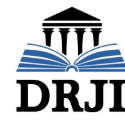Empty Calories in Processed Foods: A Comprehensive Review of Dietary Implications
DOI:
https://doi.org/10.63147/krjs.v3i04.57Abstract
Abstract
Proper food consumption is vital for human survival. The objective of this paper was to conduct a review of empty calories present in processes foods, effects, and relations. Empty calories such as junk foods, ultra processed foods, u healthy foods, fast foods are foods consumed by many because of their luring properties. However, they contain high amount of added solid fat or added sugars or sodium or additives or all. The presence of contents of empty calories elicit many effects such as obesity, diabetes, heart disease, fatigue, mental disorders, insatiety, etc. Empty calories possessed high amounts of added calories that could are not properly metabolized into useful nutrients by the body. There indeed presence of excess added sugar, excess solid fat, excess sodium. Added sugar causes insulin resistance and other comobidities, solid fat causes clogging of blood vessels and further aftermaths, sodium elicit hypertension. However, there is little or zero presence of micronutrients (vitamins and minerals) in empty calories, a situation that I cut micronutrients deficiencies and further impacts. Additionally, the additives, containers (plastics) are harmful to health as well. People easily become addicted to empty calories due to natural love for sugar, poor awareness, cheapness of the products, etc. It is emphatic to echo that, government should regularly and carefully monitor consumption and buying of empty calories in the society, parents should monitor wards, teachers and health experts should educate the public on this pressing concern
References
Abdel Ghani, S.A., Hassan, S.W.M., Shreadesh, M.A. & Shobier, A.H. (2024). Micro plastics pollution in aquatic environment: A review of abundance, distribution, and composition in the Egyptian Coastal Waters. Egyptian Journal of Aquatic Biology and Fisheries, 28(2),553-583.
Abdulrahman, D.O. & Noori, A.D., Sleman, R.M., Abdulla, D.O. & Aziz, S.A. (2022). Health hazards awareness and fast food habits among university community in Suleymanyah, Iraq. Microbial Biosystems, 7(1),28-35.
Al-Ibrahim, A. & Jackson, R.T. (2019). Lifestyle behaviors in relationship to dietary quality by diabetes status in US Adults. Journal of Nutritional Medicine and Diet Care, 5(2), 1-12.
Arya, G. & Mishra, (2013). Effects of junk food and beverages on adolescents health-A review article. IOSR Journal of Nursing and Health Science, 1(6),26-32.
Awuchi, C.G., Twinomuhwezi, H., Igwe, V.S. & Amagwula, I.O. (2020). Food additives and food preservatives for domestic and industrial food applications. Journal of Animals Health, 2(1),1-16.
British Nutrition Foundation (2023). The concept of ultra-processed foods (UPF). Nutrition.org.uk
Brunk, D. (2018). Empty calories increase risk for heart disease. Internal Medicine News, 34.
Collado-soler, R., Alferez,-Pastor, M., Trigueros, R. & Aguillar-Parra, J.(2023). A systematic review of the effects of nutrition programs in high schools. Revista Latinoamerican de psicologia, 55, 169-182.
Das, J.C. (2015). Fast food consumption in children: A review. Medical and Clinical Reviews, 1(1)1-4.
Fardet, A., Thivel, D., Gerband, L. & Rock, E. (2021). A sustainable and global health perspective of the dietary pattern of French population dietary pattern of 2015 period from INCA surveys. Sustainability,13(7433),1-13.
Gupta, R. & Yadav, R.K. (2021). Impact of chemical food preservatives on human health. PalArch's Journal of Archaeology of Egypt/Egyptology, 18(15),811-818.
Horowilz, M., Hedrick, C., Asch, A., Fernandez, S. & Churchill, K. (2023). The top foods to swap, substitute, shrink, or sneaking to reduce added sugars and solid fats in your diet. University of California
Jia, S.S., Wardak, S., Raeside, R. & Partridge, A. (2022). The impacts of junk food on health. Frontiers for Young Minds, 10(694523),1-7.
Johar, R. (2016). Empty calories and it's impact on health and wellbeing. International Journal of Arts and Education Research, 5(5),44-50.
Kaur, R. (2017). Effect of fast food on human health. International Journal of Science Technology and Management,6(3),163-165.
Khalid, N., Ali, R., Zchid, M., Zafar, L., Riaz, S. et al., (2020). Association of fast food intake as a risk factor of coronary heart disease in male population of Karachi, Pakistan. Liaquat National Journal of Primary Care, 2(2),79-82.
Kim, S., Haines, P.S., Siega-Riz, A.M. & Popkin, B.M. (2018). The diet quality index-international (DQI-1) provides an effective tool for crossnational comparison of diet quality as illustrated by China and the United States. Community and International Nutrition,3476-3484
Krazal, A. & Maillow, T., (2022). Sugar shenanigans: Curbing the added sugar epidemic in children and adolescents. Open Journal of Endocrine and metabolic Diseases, 12,184-195.
Lalnunthara, R. & Kumar, N.V.R.J. (2020). Health consciousness and fast foods: A study among college students in Lunglei Town, Mizoram. Mizoram Journal of Humanities and Social Sciences, 4(1),142-152.
Lane, M., Gamagr, E., On, S., Ashtrrr, D.N. et al., (2024). Ultra processed food exposure and adverse health outcomes. Umbrella Review of Epidemiological Meta analysis. BMJ, 384(077310),1-16.
Liebman, B. (2012). Sugar belly. Nutrition Action.
Lucan, S.C., Kurpyan, A. & Sharma, S. (2010). Storing empty calories and chronic disease risk: Snack-foods products, nutritive content and manufactures in Philadelphia corners stores. Journal of Urban Health: Bulletin of the New York Academy of Medicine,87(3),394-409.
Mageswari, P., Thilagavathi, V., Saranya, P., Priya, M.S. & Ajaydha, S. (2021). Knowledge on health effects of junk food consumption among pregnant women in Tirunelveli District. Journal of Emerging Technologies and Innovation Research,8(12), f11-f17.
Mayo Clinic News Network (2018). Does your diet contain empty calories? https://medical xpress.com/news/2018-oi-diet-calorirs.c.im/
McGill, T. (2014). The sugar debate and nutrition: Obesity and empty calories. The New Zealand Medical Journal,127(1392),6-10.
Meena, P., Nath, F. & David, F.J. (2023). Hazards of junk foods among adolescents. International Journal of Trend in Scientific Research and Development, 7(1), 115-119.
Mirza, S.H., Asema, U.K. & Kasim, S.S. (2017). To study the harmful effects of food preservatives on human health. Journal of Medicinal Chemistry and Drug Discovery, 2(2),610-616.
Mishra, V., Shrivastava, A.K., Shukla, S.P. & Ansari, M.I. (2016). Effects of sugar intake towards human health. Saudi Journal of Medicine,1(2),29-36.
Mixon, H. & Davis, M.E. (2020). Thinking about food: An analysis of calories estimation accuracy. Journal of Integrated Social Sciences,10(1),102-125.
Molnar, A. & Garcia, D.R. (2005). Empty calories: Commercializing activities in America's schools. Arizona State University.
Nagothi, K. (2021). Effects of junk food on daily life. Journal of Food Microbiology, 5(5),12.
Nicklas, T.A. & O'Neil, C.E. (2010). Development of the SOFAS (Solid Fats and Added Sugars) concept: The 2010 dietary guidelines for Americans. Advances in Nutrition,6, 368S-375S.
Nuanchankong, J., Jaroennon, P. & Manakla, A. (2024). Fasting -mimicking diets. Journal of Food Health and Bioenvironmental Science,17(2),77-84.
Oeji-Olorumtoba, O., Ajidigbi, T.S. & Jang, M. (2024). Micro plastics and nanoplastics contamination in foods: Current understanding of the health impact on human and potential solutions. European Journal of Nutrition and Food Safety 16(5),11-31.
Oki, B. & Cunningham, V. (2019). Promoting healthy eating in LAMBETH-focusing on the impact on health of hot takeaway fast food outlets.
Paglia, L. (2019). The sweet dangers of added sugars. European Journal of Pediatrics Dentistry, 20(2),89.
Rajweer, B. & Monika, O. (2012). Junk food: Impact on health. Journal of Drug Delivery and Therapeutics, 2(3), 67-73.
Reedy, J. & Krebs-Smith, S.M. (2010). Dietary sources of energy, solid fats, and added sugars among children and adolescents in the United States. Journal of American Dietetic Association, 110,1477-1484.
Rezaei, S.M.A. (2017). Frequency and attitudes to fast food consumption in Yasuj South western Iran. International Journal of Nutrition Sciences, 2(2),92-96.
Sarkingobir, Y., Waheed, S.A., Abubakar, M., & Gilani, N. (2023). Plastic waste materials in a classroom environment: An assessment of nursery classes in Sokoto state, Nigeria. Pakistan Journal of Social Science, 43(2), 217-226.
Shamsol, N.S. & Fisol, N.N.M.M. (2023). The factors that influence youth consumption of junk food. Journal of Tourism, Hospitality and Culinary Arts, 15(1),147-163.
Shankar, P., Jan, C.L., Singhi, H., Holla, A.., & Nothin, B. (2024). Impact of food preservatives on human health. Intentional Journal of Novel Research and Development, 9(3),277-286.
Sharlin, J. (2019). Sugar and added sugars: what you need to know. www.massgeneeal.org
Sharma, S. (2015). Food preservatives and their harmful effects. Intentional Journal of Scientific and Research Publications,5(4),1-2.
Sheena, (2020). Harmful impact of junk food on teenagers health in Haryana. Journal of Emerging Technologies and Innovation Research,7(9),496-503.
Shridhar, G., Rajendra, N., Murihendra, H., Shrideri, P Prasad, M., Mujeeb, M.A., Arun, S., Neeraj, D., Vikas, S., Suneel, D. & Vijay, K. (2015). Modern diet and it's impact on human health. Journal of Nutrition and Food Sciences, 5(6), 430-433.
Stenesh, J., (1998). Biochemistry. New York: springer Science + Business Media. DOI:10.1007/978-1-4757-9427-4.
Styrer, L. (1988). Biochemistry (3rd edition). New York, NY: W. H. Freeman and Company. Page 187-191.
Thakur, K., Singh, D. & Rajput, R. (2022). Effects of food additives and preservatives and shelf life of the processed foods. Journal of Current Research in Food Science, 3(2),11-22.
The Reagents of the University of Michigan (2012). Empty calories.
Udah, S. (2021). Analysis of health consequences of preservatives on agricultural foods. Direct Research Journal of Agriculture and Food Sciences, 9(1),1-6.
Umar, A.I., Sarkingobir, Y., & Dikko, M (2022). Spectro-analytical research of selected heavy metals (Cu, Cd, Cr, and Pb) in four different single-use plastics commonly in contact with food from Sokoto, Nigeria. Jurnal Teknokes,15(1),76-80
UNICEF (2019). The state of the worlds children 2019. Children, food and nutrition: Growing well in a changing world. UNICEF, New York.
UNICEF (2021). Marketing of unhealthy foods and non-alcoholic beverages to children.
Valdivia, A.E.O., Solorzano, C.R., Giammatteo, L., Montano-Osoro, C. & Marina, Y.R. (2015). The study of polymers and their impact currently to high school level: Recycling and problems with plastics, micro plastics and additives. International Journal of Science and Research, 8(12),804-810.
Vidya, B., Damayanthi, M.N. & Manjunatha, S. (2015). Junk food consumption pattern and obesity among school going children in an urban field practice area: A cross sectional study. Journal of Evidence Based Medical and Healthcare, 2(12),1845-1850
Whiteland, L. (2023). The harmful effects of serving processed food at schools. California State University.
Yale-Griffin Prevention Research Center, (2015). Empty calories. “Your road to health” activity.
Zehra, A., Shafiq, F. & Bashir, I. (2018). Junk food and associated health hazards. International Journal of Advance Research in Science and Engineering, 7(4), 975-980.
Downloads
Published
Issue
Section
License
Copyright (c) 2024 Yusuf Sarkingobir

This work is licensed under a Creative Commons Attribution-NonCommercial 4.0 International License.
This work is licensed under CC BY-NC 4.0







